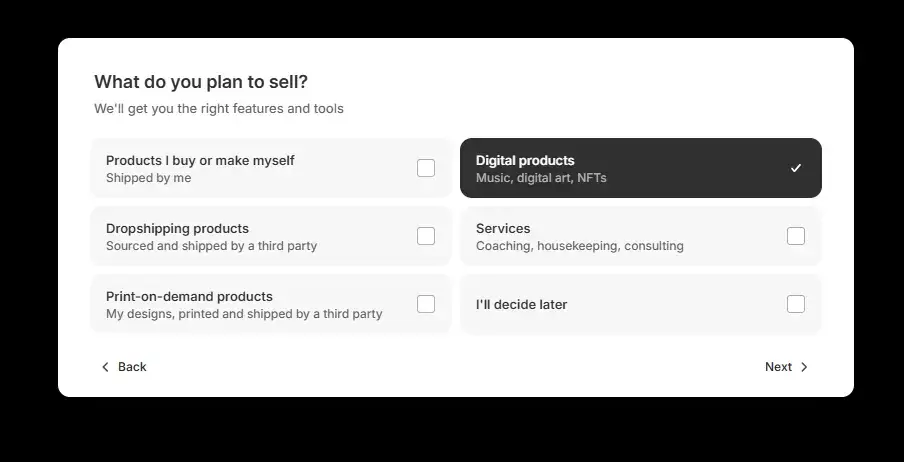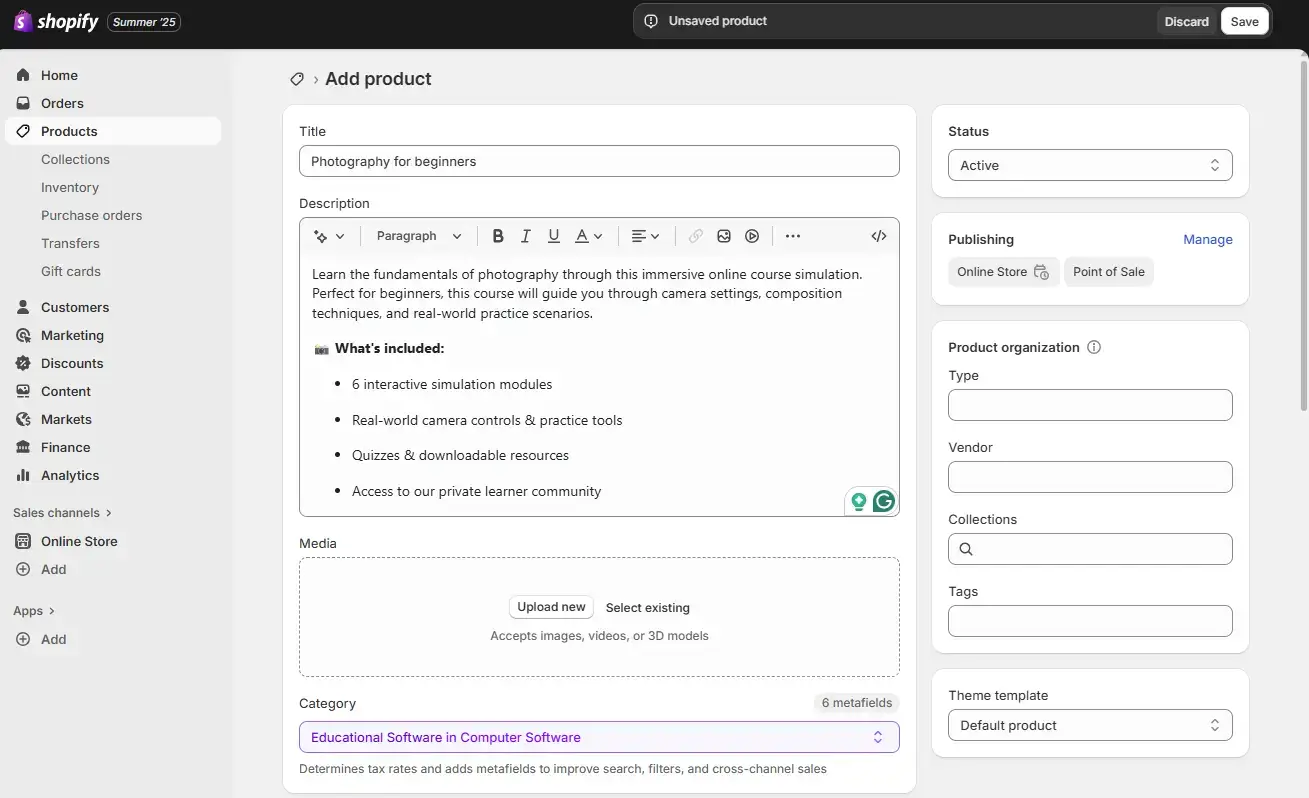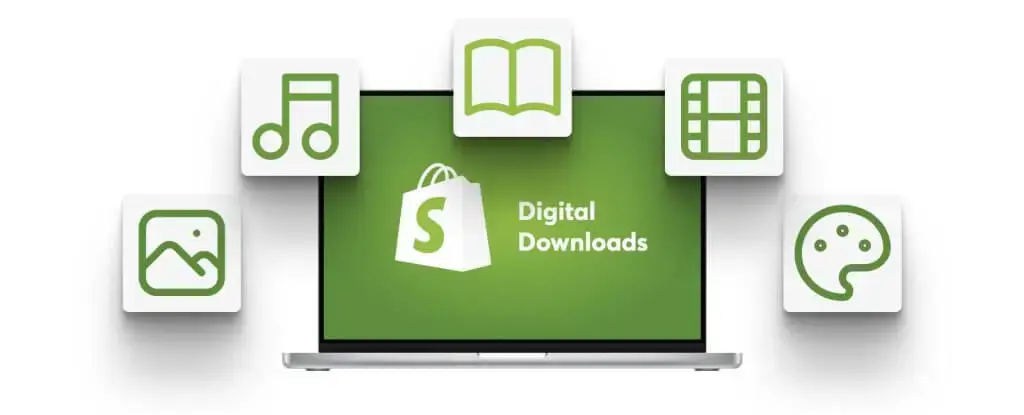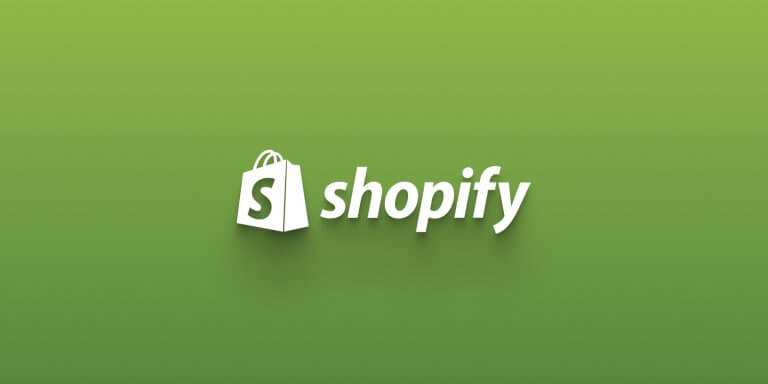Table of Contents
Publishing your course is just the beginning. The real challenge? Turning curious visitors into happy, paying students, and doing it in a way that doesn’t eat up all your time. That’s exactly where Shopify steps in.
Think of it as your business partner behind the scenes: handling payments, checkouts, upsells, and automation, while your LMS (like LearnWorlds) delivers the learning experience. Together, they form a powerful combo that helps you not just sell more, but grow smarter.
In this guide, I’ll walk you through how to sell your online courses using Shopify, from setup to optimization. Whether you’re launching your first program or building a digital course empire, you’ll learn how to create a simple, scalable sales system that works, so you can focus on what you do best.
Why Shopify pairs ideally with LMS users
Shopify turns your courses into a real business
Shopify isn’t just for physical products. It’s an ecommerce platform that makes selling digital products, including courses, much easier, especially if you’re aiming to grow. Think of it as your online storefront, checkout manager, marketing assistant, and analytics dashboard all in one.
Here’s what makes Shopify effective for course creators:
You can use your LMS to take care of the learning experience, quizzes, interactive content, community features, and let Shopify handle the sales flow. But you don’t have to choose between them. Instead, you can build a tech stack that plays to each platform’s strengths.
How Shopify complements your LMS to scale faster
Selling access to training courses is only one part of the equation. To grow a sustainable online course business, you need the right tools at each stage of the customer journey, from landing page to learning experience. This is where combining Shopify with your LMS becomes a game changer.
Your LMS delivers, Shopify sells
Think of your LMS (like LearnWorlds) as your course platform, the engine that powers online learning, hosts your course content, manages interactive elements, and issues certificates. It’s where your learners engage, learn, and succeed.
Now add Shopify to the mix. Shopify doesn’t replace your LMS, it complements it by:
This layered LMS + Shopify stack gives you a high-quality course experience paired with powerful ecommerce tools.
Scale without complexity
Many online course creators struggle with growing beyond “just one course.” But when you connect your LMS with Shopify, you can scale with:
You’re not stuck with a single funnel. You’re building a flexible ecosystem that supports online education, digital products, and even physical goods, all while creating room for passive income.
Two strategic integration paths for selling courses
One of the biggest advantages of using Shopify to sell online courses is flexibility. Whether you’re using LearnWorlds or another LMS, you can choose between two main integration paths depending on your business model and tech setup.
1. Embed your LMS into your Shopify store
This option is ideal if Shopify is your main website or storefront. With this setup, you:
This approach works especially well for ecommerce entrepreneurs who want one central hub for all digital products, physical items, and online education offers.
2. Direct traffic from your LMS to Shopify for checkout
In this setup, your LMS remains the front-facing platform for your academy. You showcase your course page, deliver the learning experience, and host any live webinars or supplementary materials on LearnWorlds.
When a user is ready to buy, you direct them to your Shopify store to complete the purchase. This allows you to:
To make this setup seamless, tools like Zapier can automate everything from customer enrollment to course access, making sure buyers get the right course access instantly, without manual work.
Choose your path based on control and complexity
If you want full control over your ecommerce store and don’t mind a slightly more complex setup, embedding your LMS into Shopify is ideal. If you prefer to keep your academy as the main website, directing purchases to Shopify is a clean and scalable approach.
Either way, Shopify empowers you to sell online, automate fulfillment, and grow your business with confidence.
Step-by-step: how to sell courses on Shopify
You’ve got a course. You’ve got students waiting. Now it’s time to set up a store that sells. Here’s how to do it without hiring a tech team..
Step 1: Set up your Shopify account and storefront
Start by signing up for a Shopify account. You don’t need to commit right away, a free trial is usually enough to test the waters.
Once you’re in, pick a theme that feels like “you.” Since you’re selling digital products, choose one that puts your course front and center. Add your logo, update the colors, and write a tagline that makes people stop and think, “I need this.”

Shopify screenshot
Step 2: Add your course as a digital product
In Shopify, courses are listed just like any other product. Head to your admin panel and create a new product:
This is the moment your course becomes something people can actually buy.

Shopify dashboard screenshot – new digital product
Step 3: Link to your course content
This is where Shopify meets your LMS. You have two options here:
Either way, the goal is simple: make sure your learners get access immediately, without needing to wait for a welcome email or manual setup.
Step 4: Customize the checkout experience
One of the best things about Shopify is the control you get over your checkout. A few quick wins here:
You can even hook up your favorite email tool, like Klaviyo, to start a welcome sequence the moment someone buys.
Step 5: Test everything, then launch
Before going live, walk through the full buyer journey yourself:
LMS + Shopify integration checklist
Before you hit publish, make sure you’ve covered the essentials:
Top Shopify apps and integrations for course sellers
Your course is ready. Your store is set up. But if you want to save time, boost revenue, and offer a smooth learning experience, it’s time to bring in the right tools.
Here’s a breakdown of the best Shopify-friendly apps and platforms that make selling online courses easier and smarter.
1. LearnWorlds
If you’re serious about course creation, LearnWorlds is hard to beat. It’s packed with everything you’d expect from a modern AI-powered LMS, interactive video, certificates, quizzes, communities, and more.
While there’s no native LearnWorlds app in the Shopify store (yet!), it connects beautifully using Zapier or simple direct access links. With this combo, you can:
Best for: Course creators who want full control over the learning experience while using Shopify for sales and automation.
2. Tevello
Tevello is a lightweight LMS-style app that lives right within your Shopify dashboard.
You can:
Just keep in mind: it’s not built for complex course ecosystems, but it’s perfect for small, streamlined offerings.
Best for: Creators who want to host their course directly in Shopify without juggling platforms.
3. Courses Plus
Another solid Shopify-native option, Courses Plus lets you:
It’s got a clean, minimal interface that’s easy to use, even if tech isn’t your thing. While it may not have the deep customization of LearnWorlds, it’s a solid start for many educators.
Best for: Beginners who want to keep tech setup light and focus on selling fast.
4. Thinkific app for Shopify
Already using Thinkific for your courses? There’s an official Shopify app. Once installed, you can:
It’s a good choice for existing Thinkific users, but switching between two dashboards may feel a bit clunky if you’re starting from scratch.
Best for: Thinkific users who want to layer ecommerce on top of their existing LMS setup.
Thinkific is easy if you’re already using it, but switching can get tricky. LearnWorlds, though, gives you a much fuller e-commerce experience. It’s great for growing your business with lower transaction fees and more ways to make it your own.
5. Zapier
Zapier is the behind-the-scenes hero. It connects Shopify to just about anything, including LearnWorlds, Thinkific, Google Sheets, your email platform, and more.
With just a few zaps (aka automated workflows), you can:
Best for: Tech-savvy creators who want to automate everything without writing code.
Shopify apps & LMS comparison for selling online courses
LearnWorlds offers the most advanced LMS features, ideal for selling interactive courses, coaching programs, and certifications.
Shopify-native apps (Tevello, Courses Plus) are great for simpler setups, but may lack depth in pedagogy, tracking, or course experience.
Zapier opens up automation possibilities between Shopify and platforms like LearnWorlds, ideal for users seeking control and customization.
5 Types of Shopify digital products to sell on your Shopify store

One of the reasons Shopify stands out is its flexibility. It’s not just for physical products, you can sell digital ones too. That means if you’re a course creator, coach, or content entrepreneur, you’ve got plenty of room to grow.
Here are five types of digital products you can start selling on your Shopify store today, even if you’re just getting started.
1. Online courses
This one’s a no-brainer. Whether you’re teaching design, marketing, yoga, or dog training, your course can live on your LMS (like LearnWorlds) and be sold through Shopify. You just list it as a digital product, then connect the checkout to your course platform using Zapier or an LMS-friendly app.
Check out the example of Supakit selling courses on Shopify and find out how they deliver them through LearnWorlds.
Struggling to pick your next course idea? Let us help you decide.
Watch our FREE webinar Choose Your (Next) Course Idea and learn how to discover and choose the perfect course topic for you and your audience!
2. Digital downloads
Think ebooks, design templates, workout plans, spreadsheets, audio files, anything your audience can download instantly.
To get started, install Shopify’s free Digital Downloads app, upload your file, and attach it to a product. That’s it. The app handles delivery automatically once someone checks out.
This works well if you’ve already got content lying around, like lead magnets or templates, that you could bundle and sell.
3. Memberships and subscriptions

One of the things Shopify is proud of is the ability it offers to its customers to sell memberships and subscriptions. So let’s say you’re an online coach, and you want to share gated content with your clients – you can choose to offer access only to your subscribers, offering different services and resources depending on their membership level.
LearnWorlds offers a robust community where you can enroll users by adding a membership fee via your shopping cart to your LearnWorlds community.
4. Services and consultations
If you’re a coach, consultant, therapist, or freelancer, you can offer your services directly. Just create a service product (like “1:1 Career Coaching Session”), set your price, and integrate a booking tool like Calendly or Acuity. Done.
It’s especially powerful when bundled with a digital product, like a workbook or mini-course to prep people before your session.
5. Experiences
Selling an event, a virtual retreat, or an in-person workshop? Shopify works for that too.
Whether it’s a wellness weekend, creative writing intensive, or private webinar series, you can sell tickets or passes just like any other product. And since experiences are highly shareable, don’t forget to promote them on social media and in your newsletter.
Word of mouth is gold here. The more excited your attendees are, the more buzz you’ll generate for the next round.
Bundle, upsell & cross-sell to increase revenue
Selling a single course is great. But if you really want to grow your income, and give your students even more value, bundling, upselling, and cross-selling are where the magic happens.
And the best part? Shopify makes all of this surprisingly simple.
Sell more than one course at a time
With Shopify, you can package multiple digital products into a single offer. Think:
Not only does this increase perceived value, it gives prospective customers a clear path to deepen their learning, and stick with your brand longer.
Use upsell workflows to raise average order value
After a customer adds a course to their cart or completes a purchase, use Shopify automation tools or apps like ReConvert to:
Upselling isn’t just about making more money. It’s about helping learners get better results through the right mix of content and tools.
Cross-sell across formats and categories
Selling a design course? Recommend a video course on branding or a downloadable kit. Promoting a fitness certification? Suggest a nutrition plan or free webinar as a follow-up.
The Shopify app store includes plenty of tools to manage these offers automatically, triggered by cart behavior, course interest, or buyer history.
Make buying effortless
None of this works if your checkout is clunky. Less friction means fewer abandoned carts which translates to more revenue (and happier customers).
Shopify’s checkout is fast and mobile-friendly. You can apply:
Marketing tactics to scale your course business
Creating a course is one thing. Getting it in front of the right people, and turning browsers into buyers, is a whole different game. The good news? Shopify gives you the tools to market smarter, not harder.
Here are the strategies that actually move the needle when you’re selling online courses.
Turn your landing page into a lead machine
Your course landing page isn’t just a product page, it’s your first impression. It should do more than explain what your course covers. It should make visitors feel like they have to enroll.
A great landing page will:
You can build these pages using Shopify’s built-in themes or third-party page builders. And once you’ve got them, don’t forget to optimize for mobile, most buyers will discover you on their phones.
Recover lost sales with abandoned cart flows
Not everyone buys on the first visit. That’s where abandoned cart emails come in. Shopify lets you send automatic follow-up emails to remind people what they left behind.
Want to make it even more effective? Sweeten the deal with:
These emails recover way more sales than you might think.
Run paid ads with purpose
Shopify integrates directly with ad platforms like Facebook, Instagram, and Google. That means you can:
If you’re running ads, track performance inside Shopify or use apps to get more detailed insights. Start small with a budget, test different audiences, and let the data tell you what’s working.
Leverage email marketing to nurture and sell
Not everyone will buy on day one, and that’s okay. Email helps you build trust over time.
Pair Shopify with tools like Klaviyo or Mailchimp to:
Pro tip: Segment your list based on what people have bought (or browsed) so you can send more relevant, personal emails.
Use analytics to guide your next move
Marketing without data is like flying blind. Shopify’s built-in analytics and add-on tools can help you figure out:
Use this info to tweak your messaging, test new pricing, or double down on what’s already working.
Pricing models that help you scale your course business
How you price your course isn’t just about what feels right, it’s about how you position your offer, attract the right audience, and generate sustainable revenue.
Shopify gives you the flexibility to try different pricing models until you find the one that works best for your content and audience. Here are a few to consider.
One-time payments: simple, clean, and conversion-friendly
If you’re just getting started, this is the easiest way to go. Set a price, list your course, and let buyers check out with a couple of clicks. No subscriptions, no follow-ups—just straightforward access.
This works great for:
You can always pair this with an upsell (like a workbook or coaching call) to increase the order value.
Subscriptions and memberships for recurring income
Looking to create stable, month-over-month revenue? Subscriptions are your friend.
You can set up:
It’s perfect if you want to build a community or offer an ongoing learning experience—and your audience gets more value over time.
Tiered pricing for flexibility
Not all students are at the same level of commitment. Tiered pricing gives them options.
Here’s how that might look:
It’s a smart way to meet people where they are—and let your most committed learners invest more.
Limited-time offers and product bundling
Nothing gets someone to hit “Buy Now” faster than a deadline or a deal.
You can use Shopify’s built-in tools to:
These kinds of offers work especially well during promotions or product launches. Just make sure your timers and discounts are clearly communicated on the page.
Overcoming tech challenges in the integration
Integrating your LMS with Shopify opens up new opportunities, but it also introduces some technical challenges. Fortunately, with the right tools and planning, most of these are easy to overcome.
Automating course access after purchase
One common challenge is ensuring that customers automatically receive access to the right online course platform after they check out on Shopify.
Here’s how to solve it:
The goal is to eliminate manual onboarding so your customers can start learning immediately, without sending emails back and forth.
Troubleshooting delivery problems
If your course is being delivered as a digital download or via a link to an external platform, make sure your settings are correct in the Shopify admin:
You can also include free resources or onboarding checklists to improve the early learning experience and reduce support tickets.
Managing user data and subscriptions
If you’re running a subscription model, use apps like Bold Subscriptions or Recharge to handle recurring payments and user access. Make sure your payment gateway supports the model you’ve chosen and always test the full flow, from cart to course delivery.
Keeping it scalable
As you grow, consider mapping your course creation and sales automations in a simple flowchart or checklist. This helps you identify bottlenecks and ensure that both your Shopify and LMS systems work together seamlessly.
Final thoughts: scale smarter, launch faster
Selling online courses is no longer just about uploading content. It’s about building a smart, scalable business, one that brings together a powerful course platform like LearnWorlds with the ecommerce strength of Shopify.
LearnWorlds powers the learning experience, from interactive elements and certifications to coaching programs and learner analytics. Shopify takes care of the sales engine, enabling you to set up a conversion-optimized online store, test pricing models, and unlock growth through digital marketing, bundles, and automation.
By integrating the two, you’re not just selling a course, you’re creating an ecosystem that drives revenue, loyalty, and lasting impact.
Start your 30-day free trial with LearnWorlds and connect it to your Shopify store to start selling with confidence. No credit card required.
Rosemary is LearnWorlds’ Content Marketing Manager. She has over 2 decades of experience in omnichannel marketing and content writing for the IT and SaaS industry. Her expertise lies in crafting effective content marketing strategies that attract, engage, and nurture customers, enabling LearnWorlds to reach its target audiences with precision.
FAQ
Everything you have ever wondered, but were too afraid to ask...





